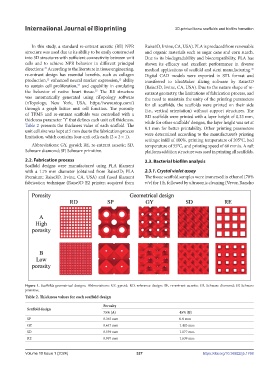Page 335 - IJB-10-1
P. 335
International Journal of Bioprinting 3D-printed bone scaffolds and biofilm formation
In this study, a standard re-entrant auxetic (RE) NPR Raise3D, Irvine, CA, USA). PLA is produced from renewable
structure was used due to its ability to be easily constructed and organic materials such as sugar cane and corn starch.
into 3D structures with sufficient connectivity between unit Due to its biodegradability and biocompatibility, PLA has
cells and to achieve NPR behavior in different principal shown its efficacy and excellent performance in diverse
directions. According to the literature in tissue engineering, medical applications of scaffold and stent manufacturing.
33
36
re-entrant design has essential benefits, such as collagen Digital CAD models were exported in STL format and
production, enhanced neural marker expression, ability transferred to IdeaMaker slicing software by Raise3D
12
12
to sustain cell proliferation, and capability in emulating (Raise3D, Irvine, CA, USA). Due to the nature shape of re-
34
the behavior of native heart tissue. The RE structure entrant geometry, the limitations of fabrication process, and
35
was automatically generated using nTopology software the need to maintain the unity of the printing parameters
(nTopology, New York, USA, https://www.ntop.com/) for all scaffolds, the scaffolds were printed on their side
through a graph lattice unit cell function. The porosity (i.e., vertical orientation) without support structures. The
of TPMS and re-entrant scaffolds was controlled with a RD scaffolds were printed with a layer height of 0.33 mm,
thickness parameter “t” that defines each unit cell thickness. while for other scaffolds’ designs, the layer height was set at
Table 2 presents the thickness value of each scaffold. The 0.1 mm for better printability. Other printing parameters
unit cell size was kept at 5 mm due to the fabrication process were determined according to the manufacturer’s printing
limitation, which contains four-unit cells each (2 × 2 × 1).
settings: infill of 100%, printing temperature of 205°C, bed
Abbreviations: GY, gyroid; RE, re-entrant auxetic; SD, temperature of 55°C, and printing speed of 60 mm/s. A raft
Schwarz diamond; SP, Schwarz primitive. platform addition structure was used in printing all scaffolds.
2.2. Fabrication process 2.3. Bacterial biofilm analysis
Scaffold designs were manufactured using PLA filament
with a 1.75 mm diameter (obtained from Raise3D; PLA 2.3.1. Crystal violet assay
Premium; Raise3D, Irvine, CA, USA) and fused filament The tissue scaffold samples were immersed in ethanol (70%
fabrication technique (Raise3D E2 printer; acquired from v/v) for 1 h, followed by ultrasonic cleaning (Vevor, Rancho
Figure 1. Scaffolds geometrical designs. Abbreviations: GY, gyroid; RD, reference design; RE, re-entrant auxetic; SD, Schwarz diamond; SP, Schwarz
primitive.
Table 2. Thickness values for each scaffold design
Porosity
Scaffold design
75% (A) 45% (B)
SP 0.365 mm 0.8 mm
GY 0.647 mm 1.403 mm
SD 0.539 mm 1.177 mm
RE 0.997 mm 1.639 mm
Volume 10 Issue 1 (2024) 327 https://doi.org/10.36922/ijb.1768

